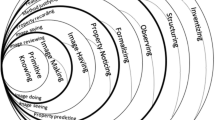Abstract
This paper analyses two components of the epistemological domain of validity of the Dynamic Geometry Environment (DGE) Cabri-géomètre: first, the nature of its phenomenological interface, and second, the possible implication on the resulting pupils' conceptions. Particularly, it is asked what effect dragging has on familiar geometric problems whose nature could be described as `static'. How do pupils apply Cabri's dynamic tools to such static problems and are there any specific approaches with their problem solving behaviour? Trying to answer such questions leads to reconstructing pupils' conceptions of ‘Cabri geometry’ and to the discussion of situated descriptions and generalisations of geometric experience in the case of Cabri.
Similar content being viewed by others
References
Balacheff, N. (1993). Artificial intelligence and real teaching. In C. Keitel and K. Ruthven (Eds.),Learning from Computers: Mathematics Education and Technology (pp. 131–158). Berlin: Springer.
Balacheff, N. and Sutherland, R. (1994). Epistemological domain of validity of microworlds. The Case of Logo and Cabri-gé omètre. Paper to IFIP, Netherlands.
Bauersfeld, H., Krummheuer, G. and Voigt, J. (1988). Interactional theory of learning and teaching mathematics and related microethnographical studies. In H. G. Steiner and A. Vermandel (Eds.),Foundations and Methodology of the Discipline Mathematics Education (pp. 174–188). Antwerp University, Antwerp.
Baulac, Y., Bellemain, F. and Laborde, J.-M. (1990).Cabri-géomètrye. Berlin: Cornelsen.
Bellemain, F and Laborde, J.-M. (1994).Cabri II. An interactive Geometry notebook. Texas Instruments.
Dörfler, W. (1993). Computer use and views of the mind. In C. Keitel and K. Ruthven (Eds.),Learning from Computers: Mathematics Education and Technology (pp. 159–186). Berlin: Springer.
Goldenberg, E. P. (1995). Ruminations about dynamic imagery (and a Strong Plea for Research). In R. Sutherland and J. Mason (Eds.),Exploiting Mental Imagery with Computers in Mathematics Education (pp. 202–224). Berlin: Springer.
Goldenberg, E. P. and Cuoco, A. (in press). What is dynamic geometry? In R. Lehrer and D. Chazan (Eds.),Designing Learning Environments for Developing Understanding of Geometry and Space. Hillsdale, N.J.: LEA publishers.
Holland, G. (1993). GEOLOG. Geometrische Konstruktionen mit dem Computer. Bonn: Dümmler.
Hölzl, R. (1994). Im Zugmodus tier Cabri-Geometrie.Interaktionsstudien and Analysen zum Mathematiklernen mit dem Computer. Weinheim: Deutscher Studien Verlag.
Hölzl, R. (1995). Between drawing and figure. In R. Sutherland and J. Mason (Eds.),Exploiting Mental Imagery with Computers in Mathematics Education (pp. 117–124). Berlin: Springer.
Hoyles, C. and Noss, R. (1992). Looking back and looking forward. In C. Hoyles and R. Noss (Eds.),Learning Mathematics and Logo (pp. 431–468). Cambridge, MA: MIT Press.
Hoyles, C. (1992). Computer-based microworlds: a radical vision or a Trojan mouse? Paper to ICME 7, Quebec, Canada.
Hoyles, C. (1993). Microworlds/Schoolworlds: The transformation of an innovation. In C. Keitel and K. Ruthven (Eds.),Learning from Computers: Mathematics Education and Technology (pp. 1–17). Berlin: Springer.
Jackiw, N. (1992).The Geometer's Sketchpad. Berkely: Key Curriculum Press.
Kadunz, G. and Kautschitsch, H. (1994). Thales: Experimentelle Geometrie mit dem Computer. Klett: Stuttgart.
Laborde, C. (1993). The computer as part of the leaming environment: The case of geometry. In C. Keitel and K. Ruthven (Eds.),Learning from Computers: Mathematics Education and Technology (pp. 48–67). Berlin: Springer.
Maier, H. and Voigt, J. (Eds.) (1991). Interpretative Unterrichtsforschung.Untersuchungen zum Mathematikunterricht Bd. 17 IDM, Köln: Aulis.
Mechling, R. (1994). Euklid. Internet: http//:wmax02.mathematik.uni-wuerzburg.de:80/ ∼weth/programme/Euklid.zip.
Neubrand, M. (1995). Multiperspectivity as a Program: On the Development of Geometry Teaching in the Past 20 Years in Austria and (West-) Germany. Paper to the ICMI-Study: Perspectives on the Teaching of Geometry for the 21 st Century, Catania, Italy.
Noss, R., Hoyles, C., Healy, L. and How, R. (1994). Constructing meanings for constructing: An exploratory study with Cabri Géomètre. In:Proceedings of PME 15, Vol. 3, Lisboa: University of Lisboa, pp. 360–367.
Pea, R. D. (1985). Beyond amplification: Using the computer to reorganize mental functioning. In:Educational Psychologist 20(4): S. 167–182.
Pea, R. D. (1987). Cognitive technologies for mathematics education. In A. Schoenfeld (Ed.),Cognitive Science and Mathematical Education (pp. 89–112). Hillsdale, N.J.: LEA publishers, S.
Polya, G. (1973). Now to solve it: a new aspect of mathematical method, 2 ed, Princeton, N.J.: Princeton University Press.
Strässer, R. (Ed.) (1991 a).Intelligente Tutorielle Systeme für das Lernen von Geometrie. Bielefeld: IDM, Universität Bielefeld (Occasional Paper 124).
Strässer, R. (1991b). Dessin et Figure. Bielefeld: IDM, Universität Bielefeld (Occasional Paper 128).
Strässer, R. (1992). Sudents' constructions and proofs in a computer environment. Bielefeld: IDM, Universität Bielefeld (Occasional Paper 134).
Yerushalmi and Schwartz (1993):The Geometric super Supposer: A laboratory for mathematical exploration, conjecture and invention. Pleasantville, N.Y.: Sunburst Communications.
Author information
Authors and Affiliations
Rights and permissions
About this article
Cite this article
Hölzl, R. How does ‘dragging’ affect the learning of geometry. Int J Comput Math Learning 1, 169–187 (1996). https://doi.org/10.1007/BF00571077
Issue Date:
DOI: https://doi.org/10.1007/BF00571077




